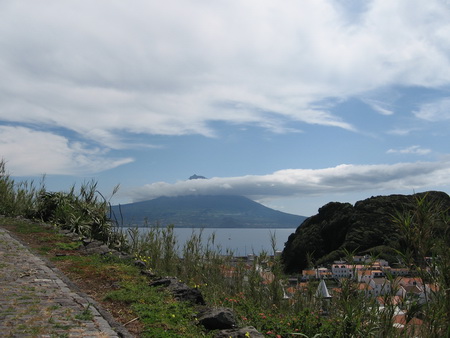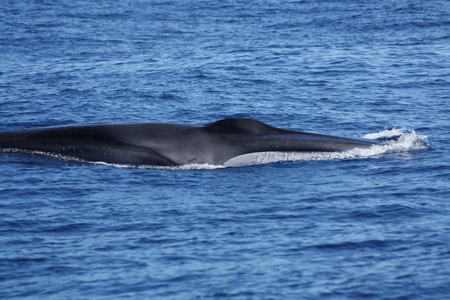Five new team members arrive to join SOTW: Anna C and Marina from MCR / SOTW team , and three students from the University of the Azores based at the Department of Fisheries (DOP) in Horta, Michelle, Malfalda and Ricardo, who are joining for the new week. We head off to the south of Pico and spend the first 2 days of the survey there, and then spend several days over the Dom João de Castro Bank and São Jorge Channel and looking for beaked whales before returning to Horta.

We set off this morning from the anchorage, the morning being sunny yet surprisingly chilly on deck. Although our objective on this trip is to see and record baleen whales, I personally really want to see a sperm whale (my role within MCR being very much office based).
We are joined by a number of playful common dolphins and some of the team are kept busy photographing them from the bow of SOTW. This is not an easy task, as capturing a fast moving dolphin jumping out of the water is rather tricky and with choppy seas at the bow, there were a few damp team members afterwards. It was some time later when more excitement erupted, when by chance I spotted a fin close to the boat. It was very exciting as this was our first large whale of the trip and my first ever. To add to my delight it was a sperm whale. It was soon apparent that there were in fact two sperm whales close together and we followed behind until they both fluked. Watching two whales that could weigh between 25 – 45 tonnes, rise up and dive in front of us was the most amazing sight, one that I will never forget. Once they had disappeared under the water we listened to their clicks and creaks on the hydrophones. The clicks are used to locate prey and the creak (sounding like a door creaking) is when they are homing in on their prey, the giant squid. After our 30 minutes experience with the sperm whales, we continued on with spirits at an all time high.
It isn’t long before a blow is spotted from the observation ‘A-frame’, and as we get closer, Olly identifies the whale as a fin whale. The fin whale is the world’s second largest animal species with adults measuring from 17 – 24 metres long. The whale got quite close, around 15 metres from the boat, and although we could mostly only see its back, at times it’s throat grooves were clearly visible. Baleen whales vocalise at low frequencies and in order to better detect these we deployed some strategically placed acoustic recording buoys, similar to those we used for the ship noise project last year, with special low frequency range hydrophones. These will record any vocalisations along with position information for later analysis. We can’t believe our luck, to see and listen to some of the largest whales on earth in one day is an incredible privilege.

For me this has been a brilliant experience, seeing the whales has been life changing and living life on the sea with such fantastic friendly dedicated team of individuals is something I won’t ever forget.
Marina
Sorry, comments are closed for this post.